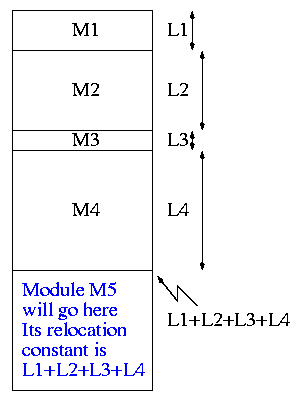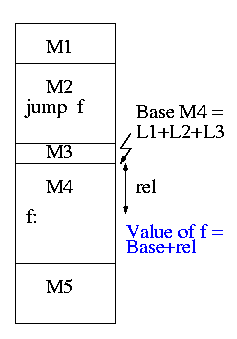Operating Systems
Chapter 0: Interlude on Linkers (covered in recitation)
Originally called linkage editors by IBM.
This is an example of a utility program included with an
operating system distribution. Like a compiler, it is not part of the
operating system per se, i.e. it does not run in supervisor mode.
Unlike a compiler it is OS dependent (what object/load file format is
used) and is not (normally) language dependent.
What does a Linker Do?
Link of course.
When the assembler has finished it produces an object
module that is almost runnable. There are two primary
problems that must be solved for the object module to be runnable.
Both are involved with linking (that word, again) together multiple
object modules. They are relocating relative
addresses and resolving external references.
- Relocating relative addresses.

- Each module (mistakenly) believes it will be loaded at
location zero (or some other fixed location). We will
use zero.
- So when there is an internal jump in the program, say jump to
location 100, this means jump to location 100 of the current
module.
- To convert this relative address to an absolute
address, the linker adds the base address of the module
to the relative address. The base address is the address at which
this module will be loaded.
- Example: Module A is to be loaded starting at location 2300 and
contains the instruction
jump 120
The linker changes this instruction to
jump 2420
- How does the linker know that Module M5 is to be loaded starting at
location 2300?
- It processes the modules one at a time. The first module is
to be loaded at location zero. So the relocating is trivial
(adding zero). We say the relocation constant is zero.
- When finished with the first module (say M1), the linker knows
the length of M1 (say that length is L1).
- Hence the next module is to be loaded starting at L1, i.e.,
the relocation constant is L1.
- In general the linker keeps track of the sum of the lengths of
all the modules it has already processed and this is the location
at which the next module is to be loaded.
- Resolving external references.

- If a C (or Java, or Pascal) program contains a function call
f(x)
to a function f() that is compiled separately, the resulting
object module will contain some kind of jump to the beginning of
f.
- But this is impossible!
- When the C program is compiled. the compiler (and assembler)
do not know the location of f() so there is no way it
can supply the starting address.
- Instead a dummy address is supplied and a notation made that
this address needs to be filled in with the location of
f(). This is called a use of f.
- The object module containing the definition of f() indicates
that f is being defined and gives its relative address (which the
linker will convert to an absolute address). This is called a
definition of f.
The output of a linker is called a load module
because it is now ready to be loaded and run.
To see how a linker works lets consider the following example,
which is the first dataset from lab #1. The description in lab1 is
more detailed.
The target machine is word addressable and has a memory of 1000 words,
each consisting of 4 decimal digits. The first (leftmost) digit is
the opcode and the remaining three digits form an address.
Each object module contains three parts, a definition list, a use
list, and the program text itself. Each definition is a pair (sym,
loc). Each use is a pair (sym, loc). The address in loc points to
the next use or is 888 to end the chain.
For those text entries that do not form part of a use chain a fifth
(leftmost) digit is added.
- If the type is 1, the address field is an immediate operand.
- If it is 2, the field is an absolute address.
- If 3, the field is a local relative address.
Input set #1
1 xy 2
1 z 4
5 31004 15678 2888 38002 7002
0
1 z 3
6 38001 1888 1001 3002 31002 21010
0
1 z 1
2 35001 4888
1 z 2
1 xy 2
3 28000 1888 2001
The first pass simply
produces the symbol table giving the values for xy and z (2 and 15
respectively). The second pass does the real work (using the values
in the symbol table).
(Unofficial) Remark:
It is faster (less I/O) to do a one pass approach, but is harder
since you need ``fix-up code'' whenever a use occurs in a module that
precedes the module with the definition.
Symbol Table
xy=2
z=15
.ft CO
+0
0: 31004 1004+0 = 1004
1: 15678 5678
2: xy: 2888 ->z 2015
3: 38002 8002+0 = 8002
4: ->z 7002 7015
+5
0 38001 8001+5 = 8006
1 1888 ->z 1015
2 1001 ->z 1015
3 ->z 3002 3015
4 31002 1002+5 = 1007
5 21010 1010
+11
0 35001 5001+11= 5012
1 ->z 4888 4015
+13
0 28000 8000
1 1888 ->xy 1002
2 z:->xy 2001 2002
The linker on unix is mistakenly called ld (for loader), which is
unfortunate since it links but does not load.
Lab #1:
Implement a linker. The specific assignment is detailed on the sheet
handed out in in class and is due 7 February. The
content of the handout is available on the web as well (see the class
home page).
End of Interlude on Linkers
Allan Gottlieb

